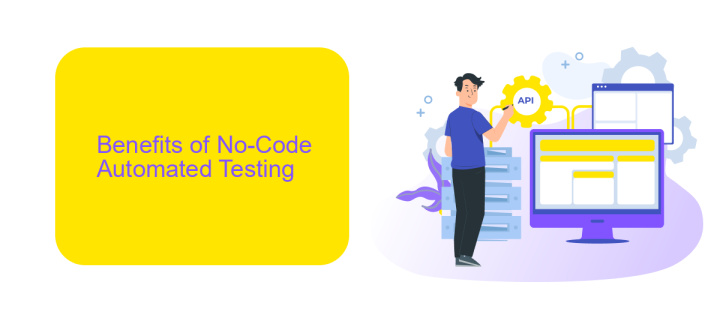No-Code Automated Testing
In the rapidly evolving landscape of software development, no-code automated testing has emerged as a game-changer. By enabling testers and developers to create and execute tests without writing a single line of code, this innovative approach accelerates the testing process, reduces errors, and enhances collaboration. Discover how no-code solutions are transforming the way we ensure software quality and reliability.
No-Code Automated Testing
No-Code Automated Testing is revolutionizing the way software testing is conducted by enabling individuals without programming skills to create and execute tests. This approach significantly reduces the time and cost associated with traditional testing methods while increasing the accessibility of testing processes.
- Simplified test creation through visual interfaces
- Reduced dependency on specialized testing personnel
- Faster identification and resolution of software issues
- Enhanced collaboration between development and QA teams
Integrating no-code testing tools with other services can further streamline the testing process. For example, ApiX-Drive allows seamless integration of various applications, enabling automated data transfer and synchronization. This ensures that test data is always up-to-date and reduces the manual effort required to maintain test environments. By leveraging such integrations, teams can achieve more efficient and effective testing workflows.
Benefits of No-Code Automated Testing

No-code automated testing offers numerous benefits, making it an attractive option for businesses of all sizes. One of the primary advantages is the significant reduction in development time. By eliminating the need for intricate coding, teams can quickly create and deploy tests, accelerating the overall software development lifecycle. This efficiency not only speeds up the release process but also allows teams to focus on more critical tasks, such as improving product quality and user experience.
Another key benefit is the accessibility it provides to non-technical team members. With no-code platforms, stakeholders from various departments can participate in the testing process, fostering better collaboration and ensuring that the software meets diverse business needs. Additionally, integrating with services like ApiX-Drive simplifies the process of connecting various applications and automating workflows, further enhancing productivity. This democratization of testing capabilities leads to more comprehensive test coverage and ultimately results in more robust and reliable software solutions.
How No-Code Automated Testing Works

No-Code Automated Testing simplifies the process of creating and executing tests without the need for programming skills. It leverages intuitive interfaces, allowing testers to define test scenarios through visual workflows and drag-and-drop functionalities.
- Define the test case: Use a visual interface to specify the steps and expected outcomes of the test.
- Configure integrations: Tools like ApiX-Drive can be used to seamlessly integrate various applications and services, ensuring smooth data flow.
- Run the test: Execute the test case and monitor the results in real-time through the platform's dashboard.
- Analyze results: Review the outcomes, identify any issues, and make necessary adjustments to the test case or the application.
This approach democratizes testing, making it accessible to non-developers and accelerating the development lifecycle. By using services like ApiX-Drive, teams can easily manage integrations, ensuring comprehensive and efficient testing processes. This ultimately leads to higher quality software and faster release cycles.
No-Code Automated Testing Tools

No-code automated testing tools have revolutionized the way businesses approach software quality assurance. These tools allow even non-technical users to create, execute, and manage tests without writing a single line of code. This democratization of testing empowers teams to deliver high-quality software faster and more efficiently.
One of the major benefits of no-code testing tools is their ease of integration with various services and platforms. For instance, ApiX-Drive offers seamless integration capabilities, enabling users to connect their testing tools with other essential services effortlessly. This not only streamlines the testing process but also enhances the overall productivity of the team.
- Ease of use with intuitive drag-and-drop interfaces
- Pre-built templates for common test scenarios
- Real-time reporting and analytics
- Integration with CI/CD pipelines
- Support for various types of tests, including functional, regression, and performance testing
In conclusion, no-code automated testing tools are a game-changer for organizations looking to optimize their software development lifecycle. By leveraging tools like ApiX-Drive for seamless integrations, teams can ensure that their testing processes are both efficient and effective, ultimately leading to higher quality software products.


Best Practices for Implementing No-Code Automated Testing
To successfully implement no-code automated testing, it's essential to start by selecting the right tools that align with your team's needs and technical expertise. Opt for platforms that offer intuitive interfaces and robust support for various testing scenarios. Ensure that the tool you choose can seamlessly integrate with your existing workflows and CI/CD pipelines to facilitate smooth operations. Regularly update and maintain your test cases to adapt to evolving requirements and avoid technical debt.
Another best practice is to foster collaboration among team members by leveraging the collaborative features of your no-code testing platform. Encourage non-technical stakeholders to participate in the testing process, which can enhance the overall quality and comprehensiveness of your tests. For seamless integration and automation, consider using services like ApiX-Drive that enable easy connection between different applications and systems without requiring extensive coding knowledge. This can significantly reduce manual efforts and improve efficiency.
FAQ
What is No-Code Automated Testing?
How does No-Code Automated Testing benefit businesses?
Can No-Code Automated Testing tools integrate with other software systems?
Is No-Code Automated Testing suitable for complex applications?
What are some challenges of No-Code Automated Testing?
Apix-Drive is a universal tool that will quickly streamline any workflow, freeing you from routine and possible financial losses. Try ApiX-Drive in action and see how useful it is for you personally. In the meantime, when you are setting up connections between systems, think about where you are investing your free time, because now you will have much more of it.

